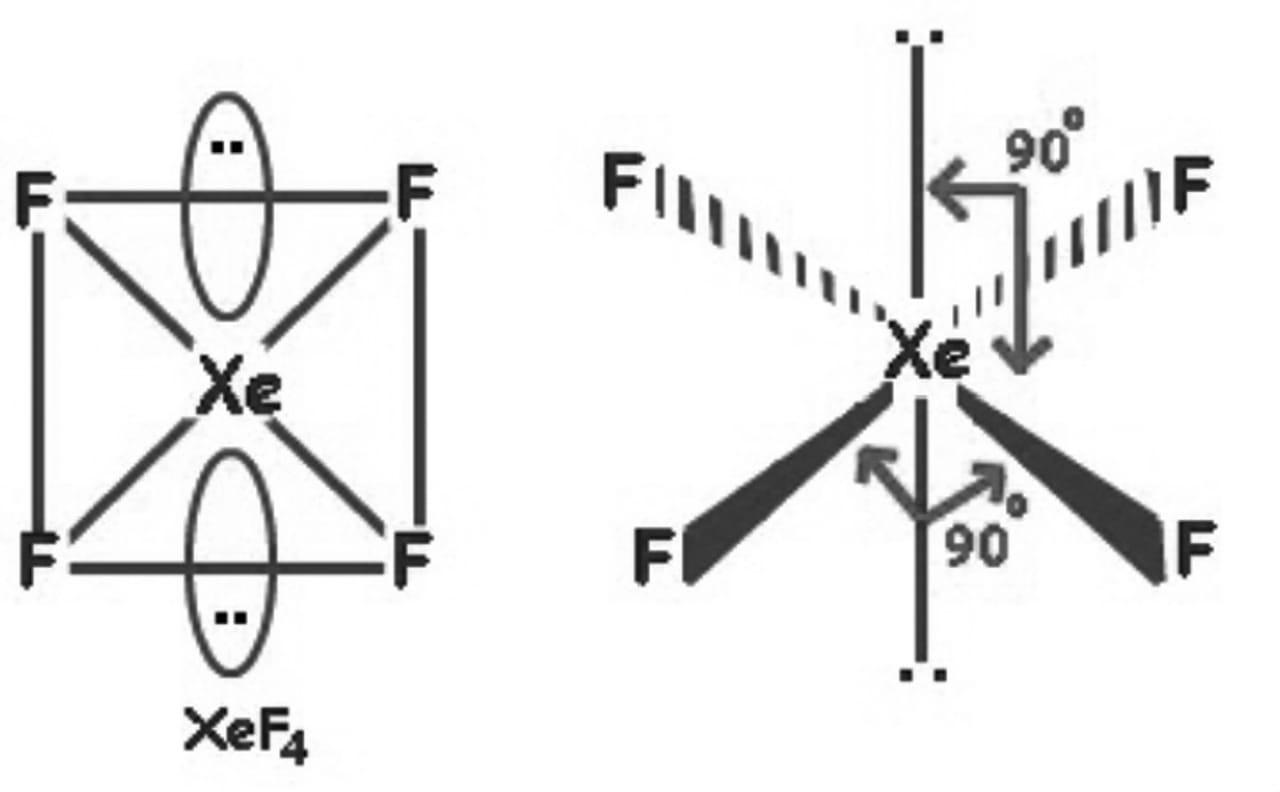
The shape of \[Xe{{F}_{4}}\] is: -
(a)- tetrahedral
(b)- octahedral
(c)- square planar
(d)- pyramidal
Answer
435.3k+ views
Hint: The shape of \[Xe{{F}_{4}}\] is based on the number of atoms joined to the central atom. Not only atoms, but lone pairs are also considered for the shape. For finding the shape of a compound the number of total number of electron pairs and number of lone pairs should be calculated with the help of valence electrons, number of bonds etc.
Complete step by step answer:
Both the VSEPR theory and the concept of hybridization are applied to predict the molecular geometries of xenon compounds.
According to the VSEPR theory, the shape of the molecule is predicted by the total number of electron pairs (lone pairs + bond pairs) in the valence shell of the central Xe atom.
To calculate the total number of electron pairs:
\[\dfrac{\text{valence electrons of central atom + number of bonded atoms}}{\text{2}}\]
With the above formula: \[\dfrac{8+4}{2}=6\]
Hence, there are 6 electron pairs.
Since there are 4 fluorine atoms joined to xenon. So, there will be a 4bond pair of electrons.
Now for calculating the number of lone pairs in the compound: -
total number of electron pairs –number of bond pairs.
Lone pairs=\[6-4=2\].
Hence, in the compound, there are 2 lone pairs.
Depending on the number of \[Xe-F\] covalent bonds to be formed, the requisite number of electrons of the of the\[5p-orbital\] valence shell of Xe get unpaired and promoted to the vacant \[5d-orbitals\] followed by hybridization.
Since, there are 6 electron pairs, the hybridization of the compound will be \[s{{p}^{3}}{{d}^{2}}\].
So, the hybridization is \[s{{p}^{3}}{{d}^{2}}\] and it has 2 lone pairs, the shape of \[Xe{{F}_{4}}\] is square planar.

Hence, the correct answer is an option (c)- square planar.
Note: Whenever you are drawing the compound structure the number of lone pairs should also be considered. In this example also there are 4 fluorine atoms with xenon, so you could get confused between tetrahedral and square planar shape.
Complete step by step answer:
Both the VSEPR theory and the concept of hybridization are applied to predict the molecular geometries of xenon compounds.
According to the VSEPR theory, the shape of the molecule is predicted by the total number of electron pairs (lone pairs + bond pairs) in the valence shell of the central Xe atom.
To calculate the total number of electron pairs:
\[\dfrac{\text{valence electrons of central atom + number of bonded atoms}}{\text{2}}\]
With the above formula: \[\dfrac{8+4}{2}=6\]
Hence, there are 6 electron pairs.
Since there are 4 fluorine atoms joined to xenon. So, there will be a 4bond pair of electrons.
Now for calculating the number of lone pairs in the compound: -
total number of electron pairs –number of bond pairs.
Lone pairs=\[6-4=2\].
Hence, in the compound, there are 2 lone pairs.
Depending on the number of \[Xe-F\] covalent bonds to be formed, the requisite number of electrons of the of the\[5p-orbital\] valence shell of Xe get unpaired and promoted to the vacant \[5d-orbitals\] followed by hybridization.
Since, there are 6 electron pairs, the hybridization of the compound will be \[s{{p}^{3}}{{d}^{2}}\].
So, the hybridization is \[s{{p}^{3}}{{d}^{2}}\] and it has 2 lone pairs, the shape of \[Xe{{F}_{4}}\] is square planar.

Hence, the correct answer is an option (c)- square planar.
Note: Whenever you are drawing the compound structure the number of lone pairs should also be considered. In this example also there are 4 fluorine atoms with xenon, so you could get confused between tetrahedral and square planar shape.
Recently Updated Pages
JEE Main 2023 (January 29th Shift 1) Physics Question Paper with Answer Key

JEE Main 2021 July 20 Shift 2 Question Paper with Answer Key

JEE Main 2023 January 30 Shift 2 Question Paper with Answer Key

JEE Main 2022 (June 24th Shift 1) Physics Question Paper with Answer Key

Equivalent Capacitance - Important Concepts and Tips for JEE

Anomalous Behaviour of Fluorine and Chemical Properties For JEE

Trending doubts
JEE Main 2025 Session 2: Application Form (Out), Exam Dates (Released), Eligibility, & More

JEE Main Exam Marking Scheme: Detailed Breakdown of Marks and Negative Marking

JEE Main 2025: Derivation of Equation of Trajectory in Physics

Electric Field Due to Uniformly Charged Ring for JEE Main 2025 - Formula and Derivation

JEE Main Participating Colleges 2024 - A Complete List of Top Colleges

Degree of Dissociation and Its Formula With Solved Example for JEE

Other Pages
JEE Advanced Marks vs Ranks 2025: Understanding Category-wise Qualifying Marks and Previous Year Cut-offs

JEE Advanced 2025: Dates, Registration, Syllabus, Eligibility Criteria and More

JEE Advanced Weightage 2025 Chapter-Wise for Physics, Maths and Chemistry

Hydrocarbons Class 11 Notes: CBSE Chemistry Chapter 9

NCERT Solutions for Class 11 Chemistry In Hindi Chapter 1 Some Basic Concepts of Chemistry

Learn About Angle Of Deviation In Prism: JEE Main Physics 2025




